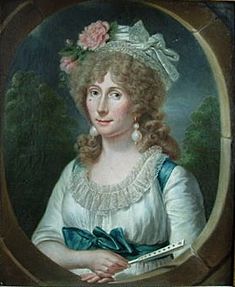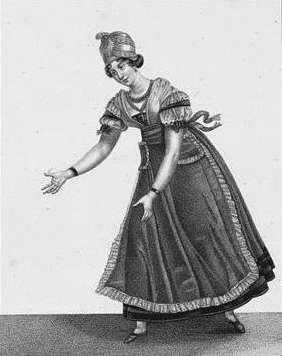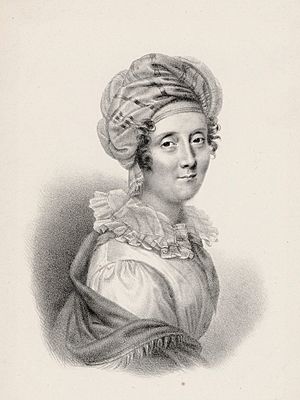Amélie-Julie Candeille facts for kids
Quick facts for kids
Amélie-Julie Candeille
|
|
|---|---|

Portrait by A. Labille-Guiard (1791)
|
|
| Born | 31 July 1767 Saint-Sulpice, Paris |
| Died | 4 February 1834 Paris |
| Nationality | French |
| Occupation | Musician, singer, actor, playwright |
| Parent(s) | |
| Position held | Sociétaires of the Comédie-Française (1785–) |
Amélie-Julie Candeille (born July 31, 1767, in Paris – died February 4, 1834, in Paris) was a very talented French artist. She was a composer, writer, singer, actress, and played many instruments.
Contents
Julie Candeille's Early Life and Talents
Julie Candeille described herself as having "bright blonde hair, brown eyes, white, fine and clear skin." People who knew her said she was pretty and graceful. She came from a musical family, which was common for women musicians back then.
Her father, Pierre-Joseph Candeille, was a composer, actor, and opera singer. He was her main teacher and helped her develop her natural talents. Julie became very good at singing and playing the harpsichord.
She performed a lot as a child in small orchestras. At age 7, she played for the French king. It is even said she played a concert with a young Mozart. By age 13, she was performing publicly as a singer, pianist, and harpist.
At 14, she joined a special group called a "masonic lodge." Here, she met important writers like Olympe de Gouges and other influential people. These connections helped her artistic career in Paris. She also had support from powerful people like the duchesse de Villeroy.
Thanks to these connections, Julie debuted at the Académie royale de Musique at age 15. She played the main role in Gluck's Iphigénie en Aulide. Her success was moderate, meaning it was okay but not amazing.
At 16, she played the fortepiano (an early piano) at the Concert Spirituel. She performed a concerto by Clementi. By this time, she was also writing her own music, including sonatas and songs. At 17, she performed a concerto that she had composed herself. A newspaper called the Mercure de France praised her, saying she had a "special talent" and a "very pleasing face."
To help her family, Julie returned to the stage. She joined the Comédie-Française at age 17. She acted in plays like Racine's Andromaque. Her performances received mixed reviews. She joined actors who supported the French Revolution in 1789.
Becoming a Playwright
In 1789, she played a young slave named Mirza in a play called L'heureux naufrage. This play, written by Olympe de Gouges, spoke out against the harsh lives of slaves in French colonies. This play caused a big debate between those who supported slavery and those who wanted to end it.
After getting mixed reviews for her acting, she left the Comédie-Française in 1789. She traveled and started writing her own dramatic music. When she returned to Paris, Julie Candeille became popular in social gatherings that supported new ideas.
In 1791, artist Adélaïde Labille-Guiard, who shared Julie's ideas, painted her portrait. During the Revolution, plays she was involved with became very popular. She joined the Théâtre de la République in 1790.
In 1792, she took part in a special event honoring General Dumouriez, a war hero. Later that year, she debuted her most famous opera, a comedy called Catherine, ou La belle fermière. Julie wrote both the words and the music for this opera, and she also starred in the main role.
This opera was performed over 150 times in the next 35 years and became famous internationally. Many versions of its songs were published for harp or piano. However, this was her biggest success, and none of her other comedic operas have survived.
Because of her connections to certain political groups, Julie Candeille faced difficulties in 1793. Despite her popularity, authorities investigated her. But thanks to a politician named Julien de Toulouse, she avoided being arrested.
A New Chapter: Madame Simons
After a difficult period in French history, Julie Candeille married a young doctor named Laroche. However, she never used his name. During this time, she became even more popular as an actress and playwright.
Her second opera, La Bayadère ou le Français à Surate, was performed in 1795. It was not as successful as Catherine. Some critics suggested her father had helped her compose Catherine. After a critical article about La bayadère, Julie published a strong response. She explained that she wrote for her love of art and to support her family.
In 1797, Julie's friend, Élise Lange, married a businessman named Michel Simons. Julie had met Michel's father, Jean Simons, in Brussels. Jean Simons was impressed by Julie and married her in Brussels on February 11, 1798. She ended her acting career to marry him.
As Madame Simons, she lived a luxurious life in Brussels and Paris. It is said that she helped her husband's business by using her connections. She reportedly helped him get a job building Napoleon's carriage for his coronation. In 1803, Julie Candeille helped organize Brussels' welcome for Napoleon and his wife.
When war started again, Jean Simons' business faced problems. Julie retired to their home in Paris. She gave piano concerts at fancy parties. She also received a pension (regular payment) from the new empress, Marie-Louise. Throughout her life, Julie Candeille supported and encouraged young musicians and other women artists.
Her Creative Works
Julie Candeille was sometimes criticized, and her stage plays received mixed reviews. She wrote 8 works for the stage, but only one, Catherine, ou La Belle fermière, still exists today.
Plays and Writings
- Catherine, ou la Belle fermière, Paris, year II.
- La Bayadère, ou le Français à Surate, Paris, year III.
- Ida, ou l'orpheline de Berlin, a play in 3 acts.
- Louise, ou la réconciliation.
- Lydie, ou les mariages manqués, Paris, 1809.
- Bathilde, reine des Francs, Paris, 1814.
- Vers sur la bonté.
- Justification de Julie Candeille en réponse à Audiffret.
- Souvenirs de Brighton, Londres et Paris, Paris, 1818.
- Agnès de France, ou le douzième siècle, Paris, 1821.
Musical Compositions
People who discussed her music often noted its beautiful melodies and simple harmonies. She composed in the style of Grétry, an artist she admired. Her keyboard pieces were very difficult to play, showing her skill.
Her surviving musical works include:
- A concerto for keyboard (piano or harpsichord) and strings.
- Three sonatas for harpsichord, some with violin accompaniment.
- Two great-sonatas for piano, opus 8 (published under the name Julie Simons).
- A Fantaisie for piano.
- A Nocturne for piano.
Many of her other works, like more sonatas and duos, are now lost. Modern versions of her keyboard concerto, three songs, and the overture from Catherine are available today.
See also
 In Spanish: Julie Candeille para niños
In Spanish: Julie Candeille para niños



